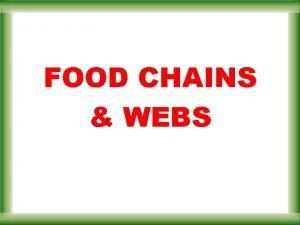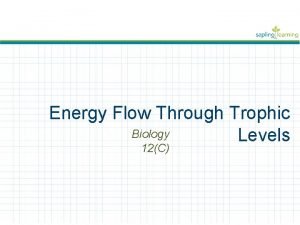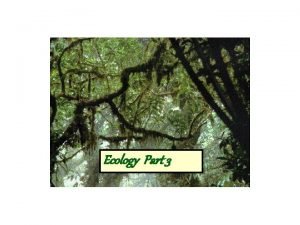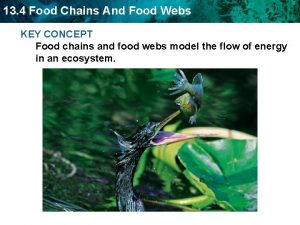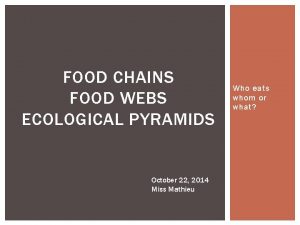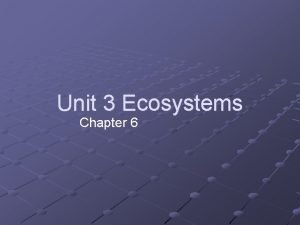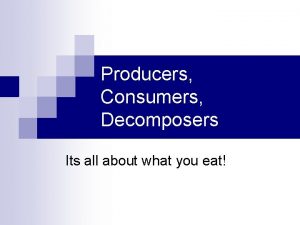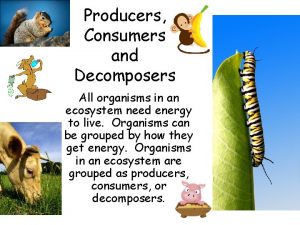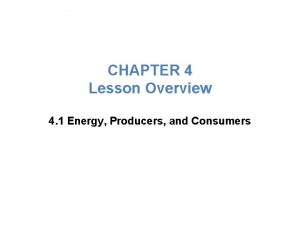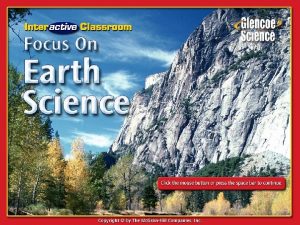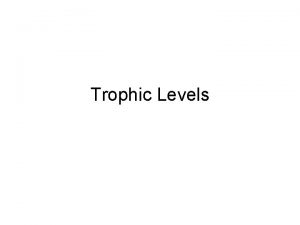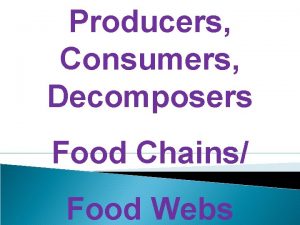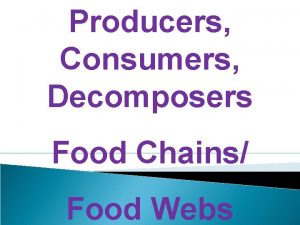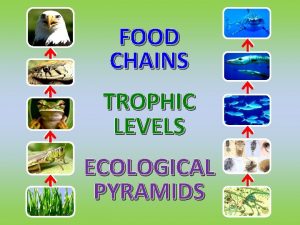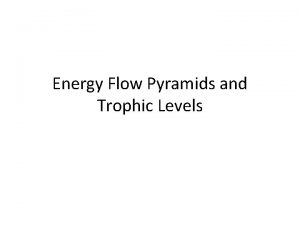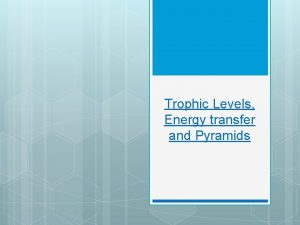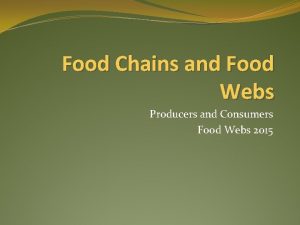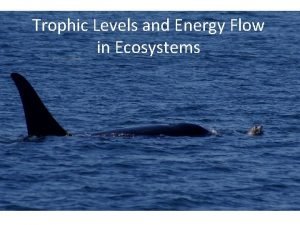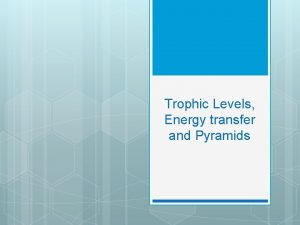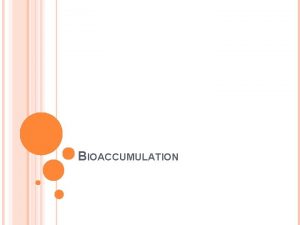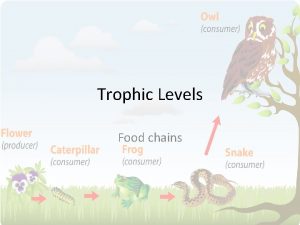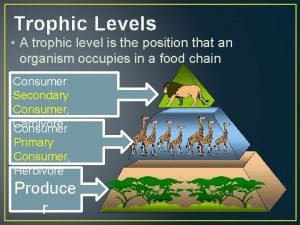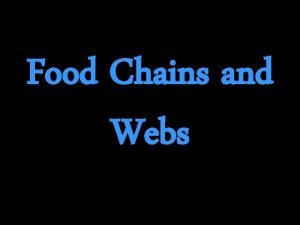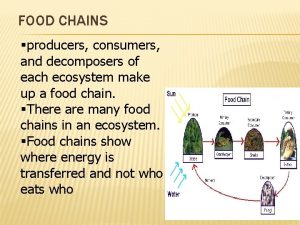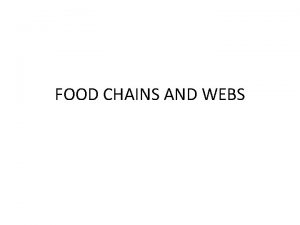Trophic Levels and Food Chains The producers consumers




















- Slides: 20

Trophic Levels and Food Chains • The producers, consumers, and decomposers of each ecosystem make up a food chain. • There are many food chains in an ecosystem. • Food chains show where energy is transferred and not who eats who. Copyright © 2003 Pearson Education, Inc. publishing as Benjamin Cummings

Example of a Food Chain – Simple… Copyright © 2003 Pearson Education, Inc. publishing as Benjamin Cummings

Trophic Levels and Food Chains Quaternary consumers Food Chain: Set of food (energy) transfer from trophic level to trophic level Carnivore Tertiary consumers Carnivore Secondary consumers Carnivore Primary consumers Zooplankton Herbivore Producers Plant A terrestrial food chain Copyright © 2003 Pearson Education, Inc. publishing as Benjamin Cummings Phytoplankton A marine food chain

Food Webs – Complex Quickly… Copyright © 2003 Pearson Education, Inc. publishing as Benjamin Cummings

Quaternary, tertiary, and secondary consumers Tertiary and secondary consumers Secondary and primary consumers Producers (plants) Copyright © 2003 Pearson Education, Inc. publishing as Benjamin Cummings

Decomposers • What is a decomposer and what do they do? What trophic level would you put them at? • Derive their energy from the dead material left by all trophic levels • Are often left off of most food chain diagrams Copyright © 2003 Pearson Education, Inc. publishing as Benjamin Cummings

Questions: 1. What is a trophic level? – A trophic level is the position occupied by an organism on a food chain 2. What are three types of pyramids? – Pyramid of: Energy, Numbers, Biomass 3. How do the pyramids differ? – Differ in what they measure 4. What is on the bottom layer of all the pyramids? – Producers/Autotrophs 5. What is on the top layer of all pyramids? – Apex Predator (organism a the top of the food chain) Copyright © 2003 Pearson Education, Inc. publishing as Benjamin Cummings

Trophic Levels • A trophic level is the position occupied by an organism in a food chain. • Producers are found at the base of the pyramid and compromise the first trophic level. • Primary consumers make up the second trophic level. • Secondary consumers make up the third trophic level. • Finally Tertiary consumers make up the top trophic level. Copyright © 2003 Pearson Education, Inc. publishing as Benjamin Cummings

Trophic Levels Found on an Energy Pyramid • Trophic levels can be analyzed on an energy pyramid. • The greatest amount of energy is found at the base of the pyramid. • The least amount of energy is found at top of the pyramid. Copyright © 2003 Pearson Education, Inc. publishing as Benjamin Cummings

Does all the energy this caterpillar eats get passed to the bird who eats him? Plant material eaten by caterpillar 100 kilocalories (kcal) 35 kcal 50 kcal Feces Cellular respiration 15 kcal Growth Figure 19. 25 Copyright © 2003 Pearson Education, Inc. publishing as Benjamin Cummings

Pyramid of Energy A diagram that represents the cumulative loss of energy from a food chain Copyright © 2003 Pearson Education, Inc. publishing as Benjamin Cummings

What happens to energy as you go up trophic levels? Why? Tertiary consumers 10 kcal Secondary consumers 100 kcal Primary consumers Producers 1, 000 kcal 10, 000 kcal Figure 19. 26 Copyright © 2003 Pearson Education, Inc. publishing as Benjamin Cummings

Pyramid of Numbers A diagram that represents the actual number of organisms present at each trophic level Copyright © 2003 Pearson Education, Inc. publishing as Benjamin Cummings

Pyramid of Numbers 1 Copyright © 2003 Pearson Education, Inc. publishing as Benjamin Cummings

Pyramid of Numbers 2 Copyright © 2003 Pearson Education, Inc. publishing as Benjamin Cummings

Pyramid of Numbers 3 Copyright © 2003 Pearson Education, Inc. publishing as Benjamin Cummings

Biomass • Energy is sometimes considered in terms of biomass, the mass of all the organisms and organic material in an area. • There is more biomass at the trophic level of producers and fewer at the trophic level of tertiary consumers. (There are more plants on Earth than there animals. ) • Bio=life Mass=weight • Bio + Mass = Weight of living things within an ecosystem. Copyright © 2003 Pearson Education, Inc. publishing as Benjamin Cummings

Pyramid of Biomass vs. Pyramid of Numbers Copyright © 2003 Pearson Education, Inc. publishing as Benjamin Cummings

Pyramids Copyright © 2003 Pearson Education, Inc. publishing as Benjamin Cummings

Homework: • Finish up to: Pyramid for Biomes Project (must be your own work!!) • Chapter 2 Review: 1, 3, 4, 6 -8, 10, 11, 15, 17 bcd, 18, 20 • Chapter 2 Checkpoint Next Class! Copyright © 2003 Pearson Education, Inc. publishing as Benjamin Cummings
 Producer in food chain
Producer in food chain Producers primary consumers secondary consumers
Producers primary consumers secondary consumers Producers food chain
Producers food chain Detritivores
Detritivores What is a decomposer in the food web
What is a decomposer in the food web Trophic level
Trophic level Taiga food chain
Taiga food chain Specialist food web
Specialist food web Trophic levels in a food chain
Trophic levels in a food chain Section 4: food chains and food webs
Section 4: food chains and food webs Food chains, food webs and ecological pyramids
Food chains, food webs and ecological pyramids Food webs and energy pyramids answer key
Food webs and energy pyramids answer key Desert food chain
Desert food chain Difference between food chain and food web
Difference between food chain and food web Producer consumer decomposer activity
Producer consumer decomposer activity Is a cockroach a consumer producer or decomposer
Is a cockroach a consumer producer or decomposer Is a horse a producer consumer or decomposer
Is a horse a producer consumer or decomposer What are 3 producers
What are 3 producers Chapter 4 lesson 1 energy, producers and consumers
Chapter 4 lesson 1 energy, producers and consumers Consumers producers and the efficiency of markets
Consumers producers and the efficiency of markets Energy producers and consumers lesson 1
Energy producers and consumers lesson 1



